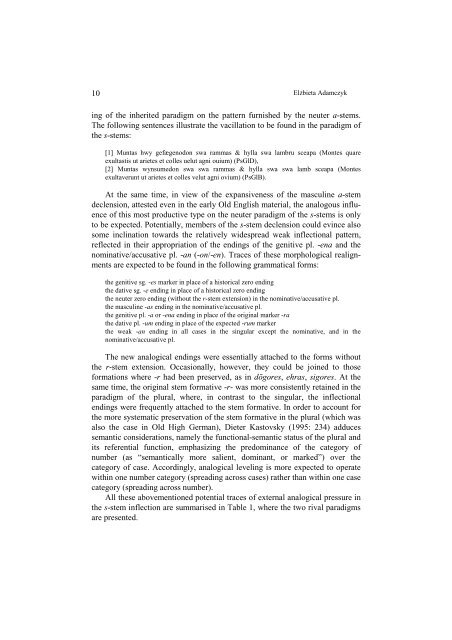s - Wyższa SzkoÅa Filologiczna we WrocÅawiu
s - Wyższa SzkoÅa Filologiczna we WrocÅawiu
s - Wyższa SzkoÅa Filologiczna we WrocÅawiu
Create successful ePaper yourself
Turn your PDF publications into a flip-book with our unique Google optimized e-Paper software.
10<br />
Elżbieta Adamczyk<br />
ing of the inherited paradigm on the pattern furnished by the neuter a-stems.<br />
The following sentences illustrate the vacillation to be found in the paradigm of<br />
the s-stems:<br />
[1] Muntas hwy gefægenodon swa rammas & hylla swa lambru sceapa (Montes quare<br />
exultastis ut arietes et colles uelut agni ouium) (PsGlD),<br />
[2] Muntas wynsumedon swa swa rammas & hylla swa swa lamb sceapa (Montes<br />
exultaverunt ut arietes et colles velut agni ovium) (PsGlB).<br />
At the same time, in view of the expansiveness of the masculine a-stem<br />
declension, attested even in the early Old English material, the analogous influence<br />
of this most productive type on the neuter paradigm of the s-stems is only<br />
to be expected. Potentially, members of the s-stem declension could evince also<br />
some inclination towards the relatively widespread <strong>we</strong>ak inflectional pattern,<br />
reflected in their appropriation of the endings of the genitive pl. -ena and the<br />
nominative/accusative pl. -an (-on/-en). Traces of these morphological realignments<br />
are expected to be found in the following grammatical forms:<br />
the genitive sg. -es marker in place of a historical zero ending<br />
the dative sg. -e ending in place of a historical zero ending<br />
the neuter zero ending (without the r-stem extension) in the nominative/accusative pl.<br />
the masculine -as ending in the nominative/accusative pl.<br />
the genitive pl. -a or -ena ending in place of the original marker -ra<br />
the dative pl. -um ending in place of the expected -rum marker<br />
the <strong>we</strong>ak -an ending in all cases in the singular except the nominative, and in the<br />
nominative/accusative pl.<br />
The new analogical endings <strong>we</strong>re essentially attached to the forms without<br />
the r-stem extension. Occasionally, ho<strong>we</strong>ver, they could be joined to those<br />
formations where -r had been preserved, as in dōgores, ehras, sigores. At the<br />
same time, the original stem formative -r- was more consistently retained in the<br />
paradigm of the plural, where, in contrast to the singular, the inflectional<br />
endings <strong>we</strong>re frequently attached to the stem formative. In order to account for<br />
the more systematic preservation of the stem formative in the plural (which was<br />
also the case in Old High German), Dieter Kastovsky (1995: 234) adduces<br />
semantic considerations, namely the functional-semantic status of the plural and<br />
its referential function, emphasizing the predominance of the category of<br />
number (as “semantically more salient, dominant, or marked”) over the<br />
category of case. Accordingly, analogical leveling is more expected to operate<br />
within one number category (spreading across cases) rather than within one case<br />
category (spreading across number).<br />
All these abovementioned potential traces of external analogical pressure in<br />
the s-stem inflection are summarised in Table 1, where the two rival paradigms<br />
are presented.
















